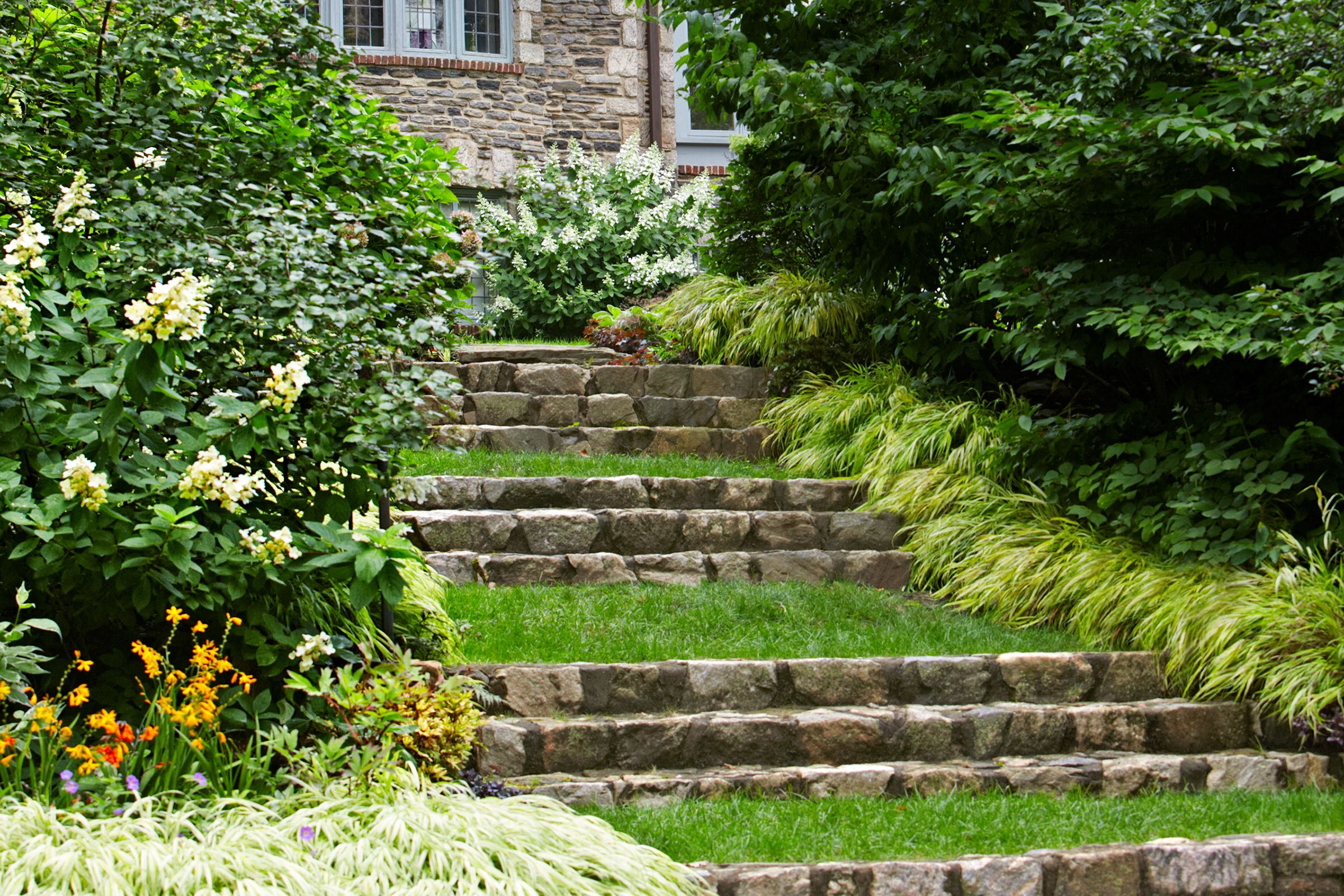A lot perched up high has its charms—ample opportunities for lofty views and even a bit of seclusion from the rest of the world—but it can also come with more than the usual challenges.
Privacy and quiet aren’t so easy to achieve when it’s a corner property and two sides are exposed to the neighborhood. Add to that the sloping terrain—how and what do you plant to keep it stable, yet pleasing?—and turning a hillside into a beautiful and useful landscape can feel like an uphill battle.
The Garden Plan
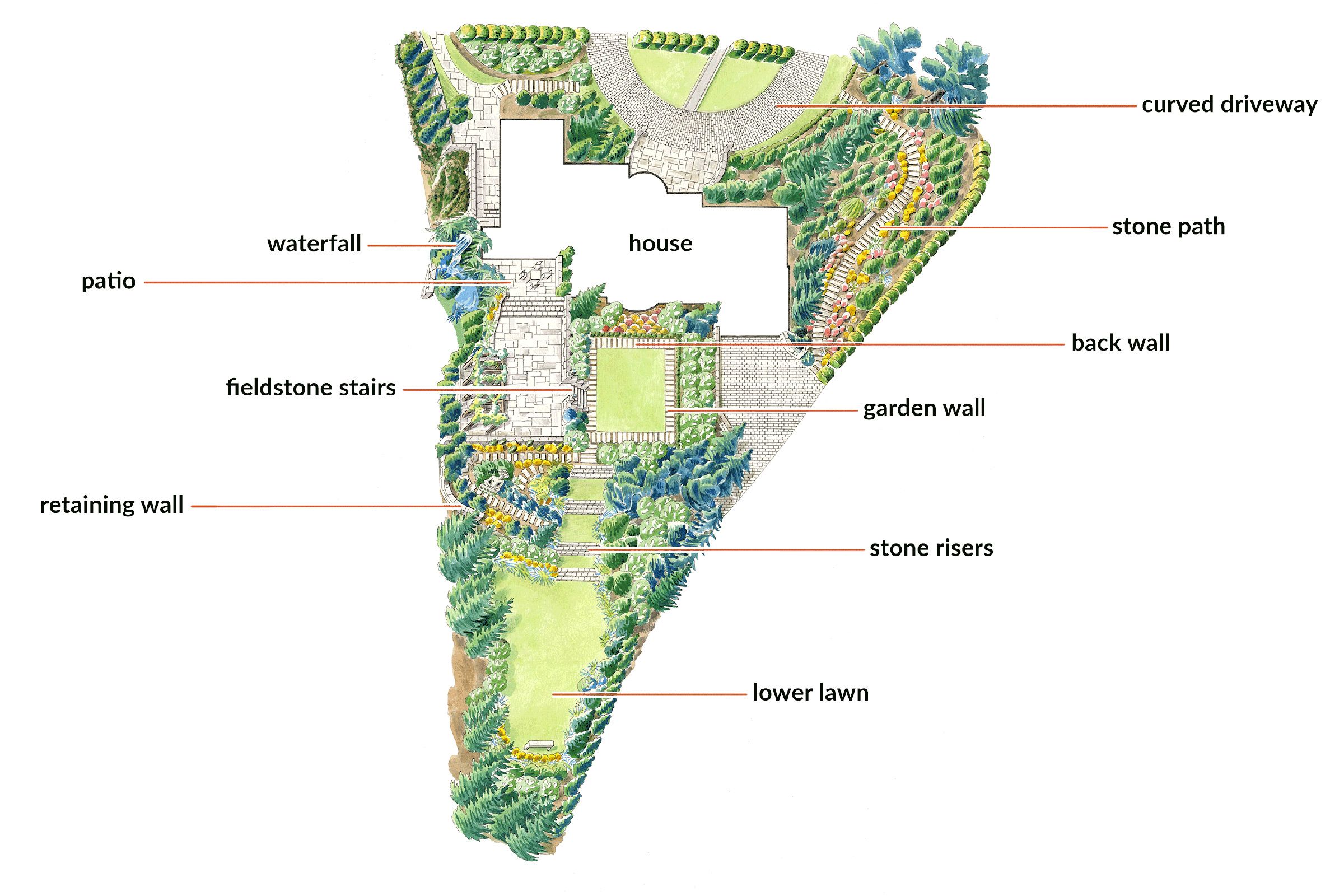
A small circular driveway leads to the front of the house. In back, the teardrop-shaped sloping one-acre lot was turned into a series of connecting outdoor rooms. Immediately off the back left of the house, a small patio gives way to a large terrace for entertaining. Wide, turf-topped steps at the backyard’s center help tame the hill and provide a transition from the upper to the lower lawn. On the upper right corner, a steep hill now blooms as a fragrant prairie.
Garden Wall with Lush Plantings
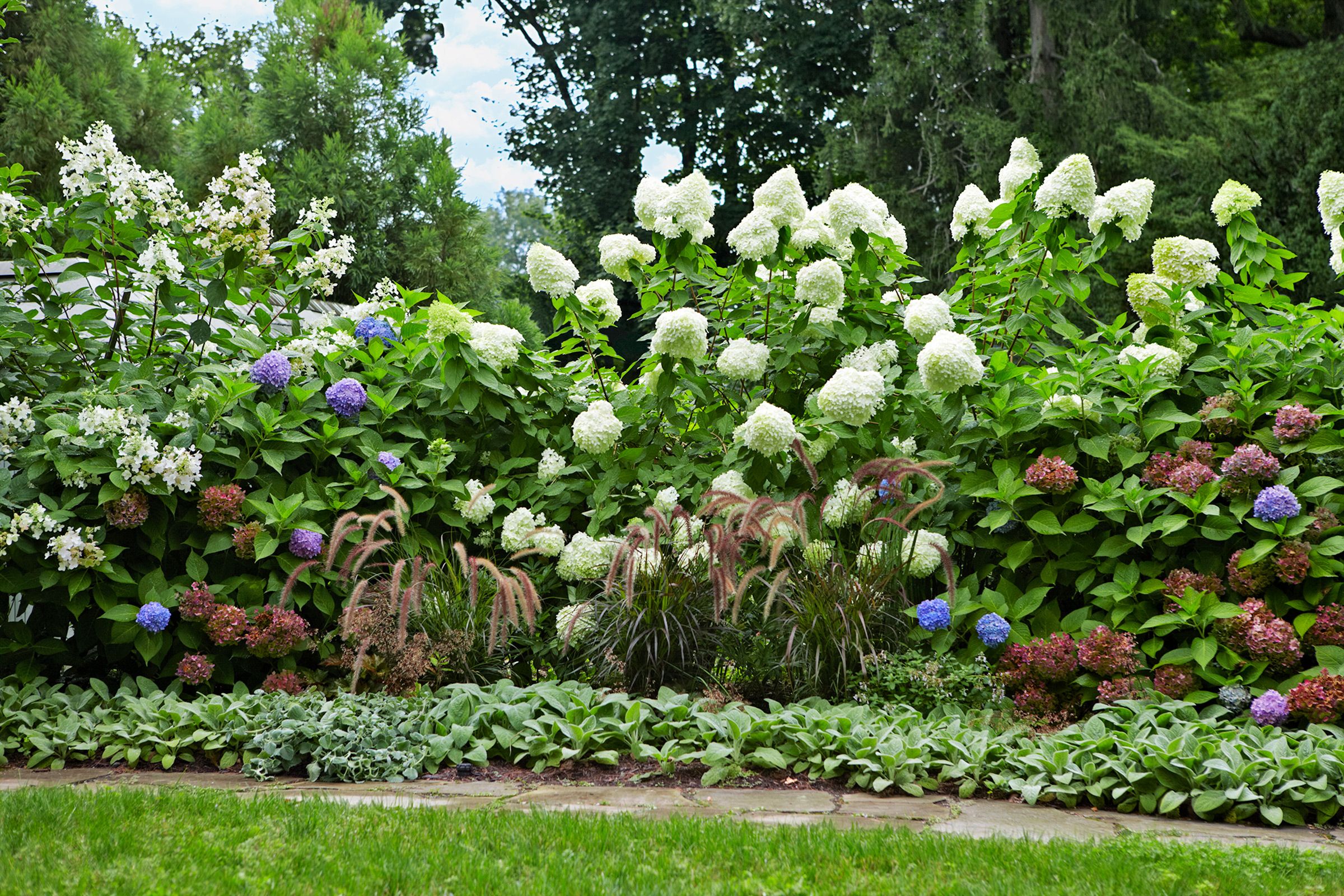
Such was the project that landscape designer Robert Welsch (Westover Landscape Design, Tarrytown, NY) took on and, as seen here, transformed with a series of lush, elegant garden rooms. When the owners of this impressive 1910 Tudor Revival house in a close-by suburb of New York City asked him to revamp a rock garden and waterfall just off the back patio, the rest of the yard was overgrown, rock-strewn, and patchy with struggling turf, with terrain that fell steeply away from the house.
In no time, a meeting of the minds led the homeowners to commission Welsch to transform the entire acre. On their wish list: multilevel outdoor spaces, each with a different mood, to enjoy with extended family who visit each summer, and plants that pump out plenty of color and fragrance. Here are the steps he took to tame the slope and create that longed-for series of special destination areas.
Curved Driveway
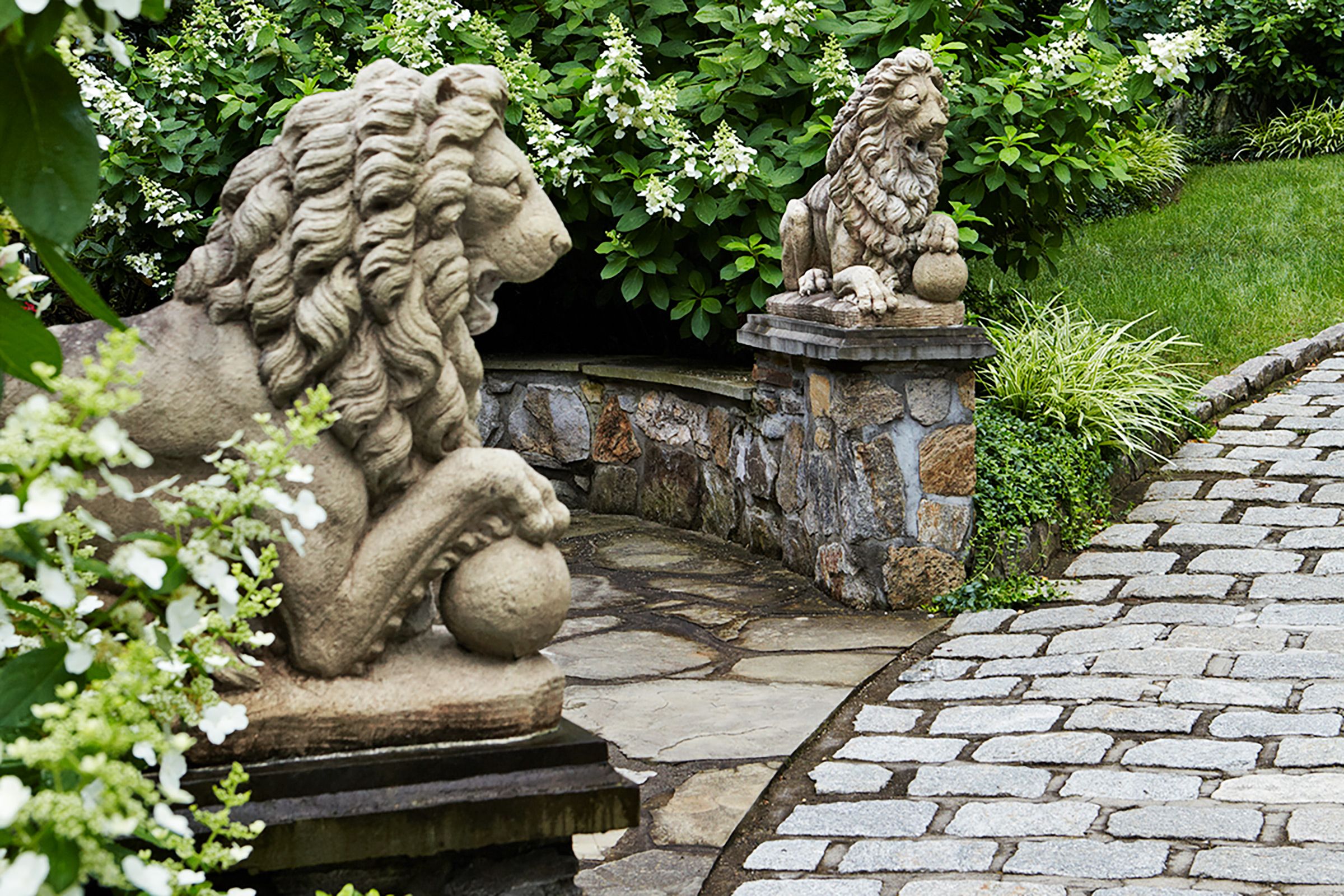
Providing a large, level platform just steps from the back door is a sure way to invite outdoor exploration. A small existing patio was fine for family meals alfresco, but it couldn’t hold a crowd, so the owners hired a contractor to build an adjoining terrace about four times the size of the patio. Welsch then came in to tackle the small waterfall and rock garden beside the patio.
Overgrown plantings had obscured the view of the water feature, and falling plant debris was a hazard for the fish in the pond at its base. Welsch cleaned up the area, reinforcing the planting pockets with native stone, then inserting ornamental grasses that also act as a privacy screen. To complete the rest of the grounds, he had trucked in 5 tons of stone, along with some 160 yards of fill and topsoil, to build retaining walls, staircases, and pathways leading to and through other garden rooms he then created.
Stone Path Through a Dramatically Sloped Lawn
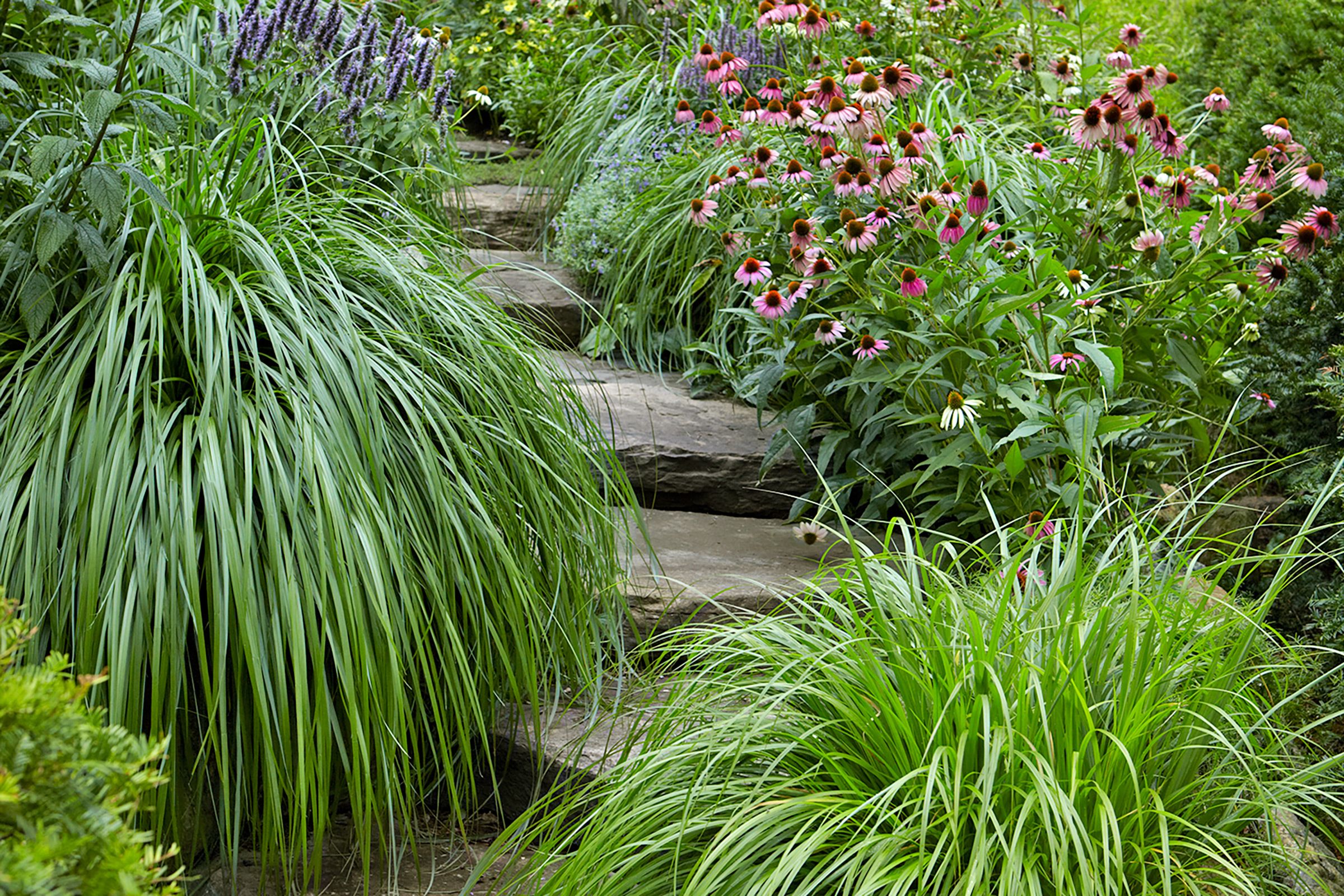
Too much turf with too much of a pitch is both unnavigable and uninteresting. So Welsch divided the central area of the backyard into two areas of turf. A formal rectangle of lawn, centered behind the house, sits just off the entertaining terrace (which is nearly the same size). With its wide frame of flat fieldstone and layered borders of flowering shrubs, grasses, and perennials, the owners call this their “stroll garden,” a spot for a postmeal meander.
Back Wall of the House
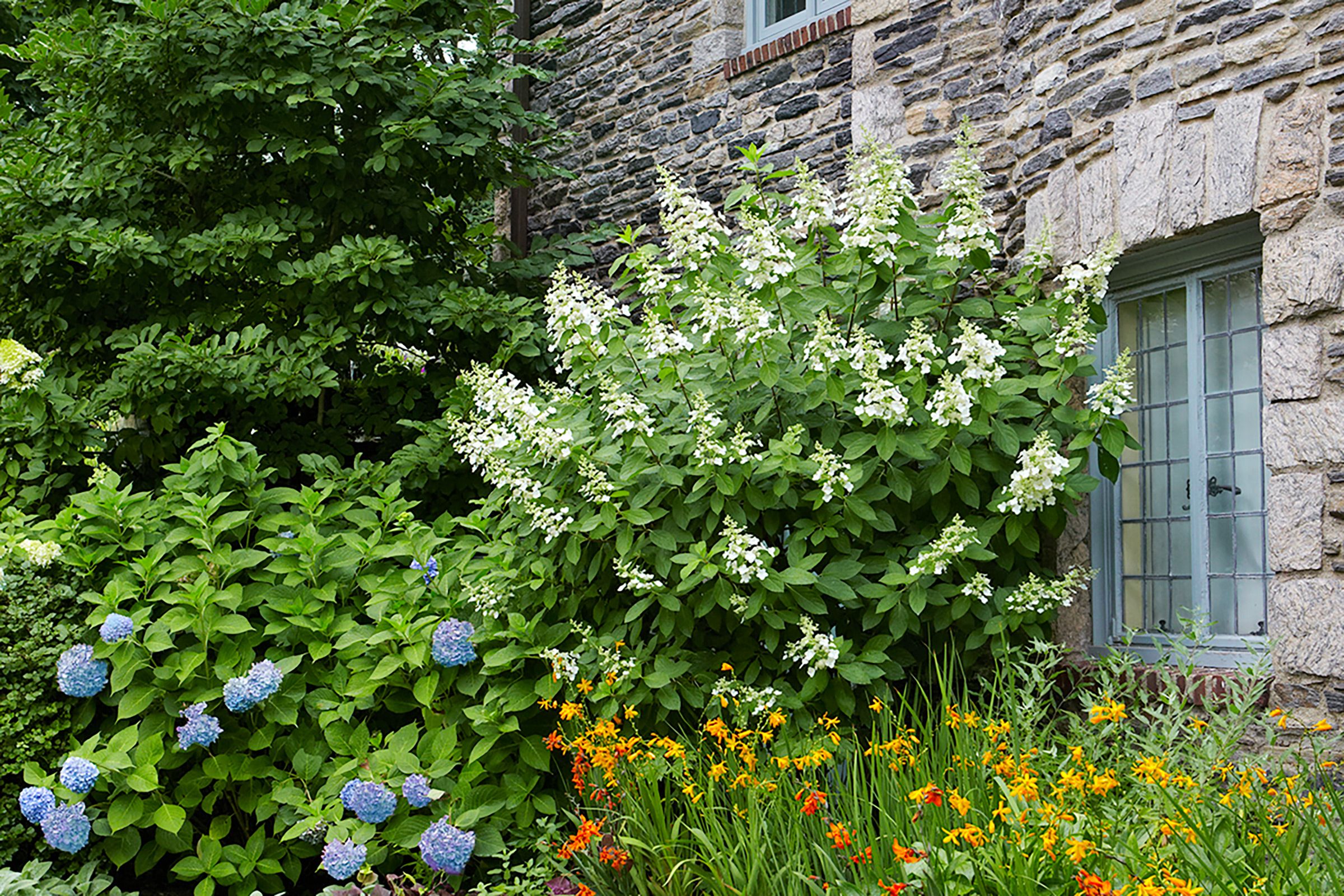
A lower triangle of lawn at the lot’s far end is capped with a stone bench at its furthermost point, shielded from the street by a mixed planting of evergreen trees and flowering shrubs. It provides a quiet resting place as well as an impressive view up toward the house.
To connect the two lawns and mitigate the steep grade change, Welsch orchestrated a 20-foot-wide staircase made up of three grass landings, each about 4 feet deep, taken in two easy strides, “to slow the pace,” he says. Granite Belgian blocks form four sets of three steps. In spring, the steps offer a scent tunnel for the aroma of lilac blooms wafting up from the lower garden. And when a summer thunderstorm hits, the permeable turf doesn’t turn into a river, the way a solid stone staircase could.
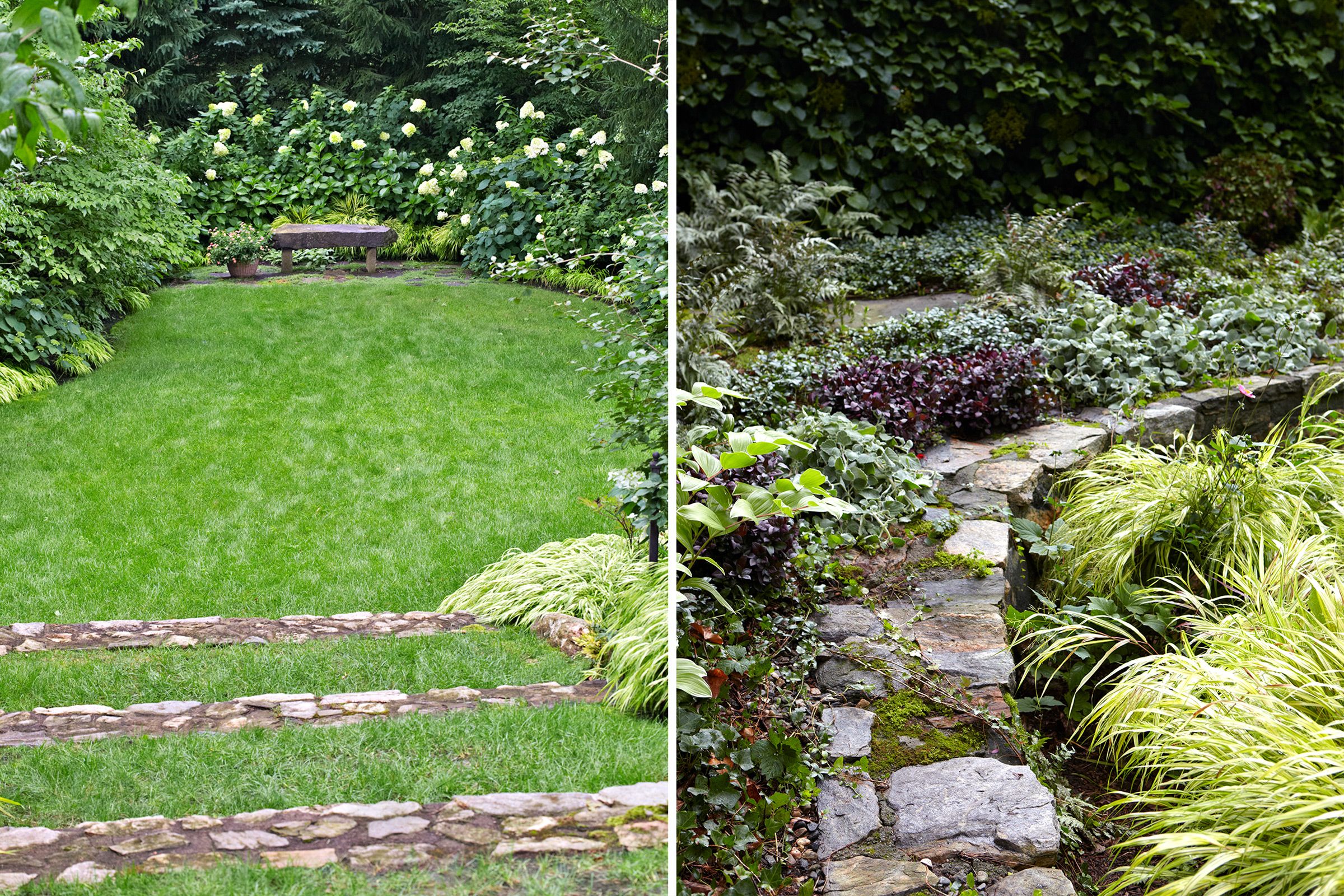
Lower Lawn
Soften stonework’s hard edges with greenery. The combination of a stone house and stone hardscaping can overwhelm a landscape and start to look like a paved paradise. So Welsch layered borders close to the house as well as around the two lawns and the shade garden with grasses, shrubs, and other plants of graduating heights to partially conceal the stone. Repeating some plants—like ‘Annabelle’ and ‘Endless Summer’ hydrangeas, purple fountain grass with its distinctive tassels, red and yellow crocosmia, and lamb’s ear—also serves to unify the overall landscape.
On the stone entertaining terrace, he filled built-in planters with colorful annuals, including lantana, bacopa, and million bells. Vines like passionflower on the side of the house facing the patio help fulfill the owners’ request for fragrance. Japanese forest grass dots the stone pathways as well as the waterfall to further soften the appearance of the hard surfaces throughout.
Retaining Wall
Take advantage of mature trees. Besides providing privacy and muffling noise, mature trees, with their established roots, help keep a slope intact. The property came with towering white pines, Norway maples, and a graceful old cherry. Despite the overgrown thicket between the terrace and the lower lawn, the owners were reluctant to remove trees that shielded the property from neighbors. So Welsch harnessed their canopy for a shade garden. He cleared out overgrown ivy and replaced it with shade-loving, low-maintenance plants like cinnamon fern, Japanese painted fern, variegated Solomon’s seal, and ‘Jack Frost’ brunnera.
Adding a clumping bamboo provided a midlevel privacy screen and formed a backdrop for a dramatic stone Buddha statue. A path leads into and through this meditative retreat from the stroll garden. Vinca serves as a groundcover, producing periwinkle-blue flowers in spring. Climbing hydrangea covers the retaining wall for the garden below and masks unsightly drainage pipes.
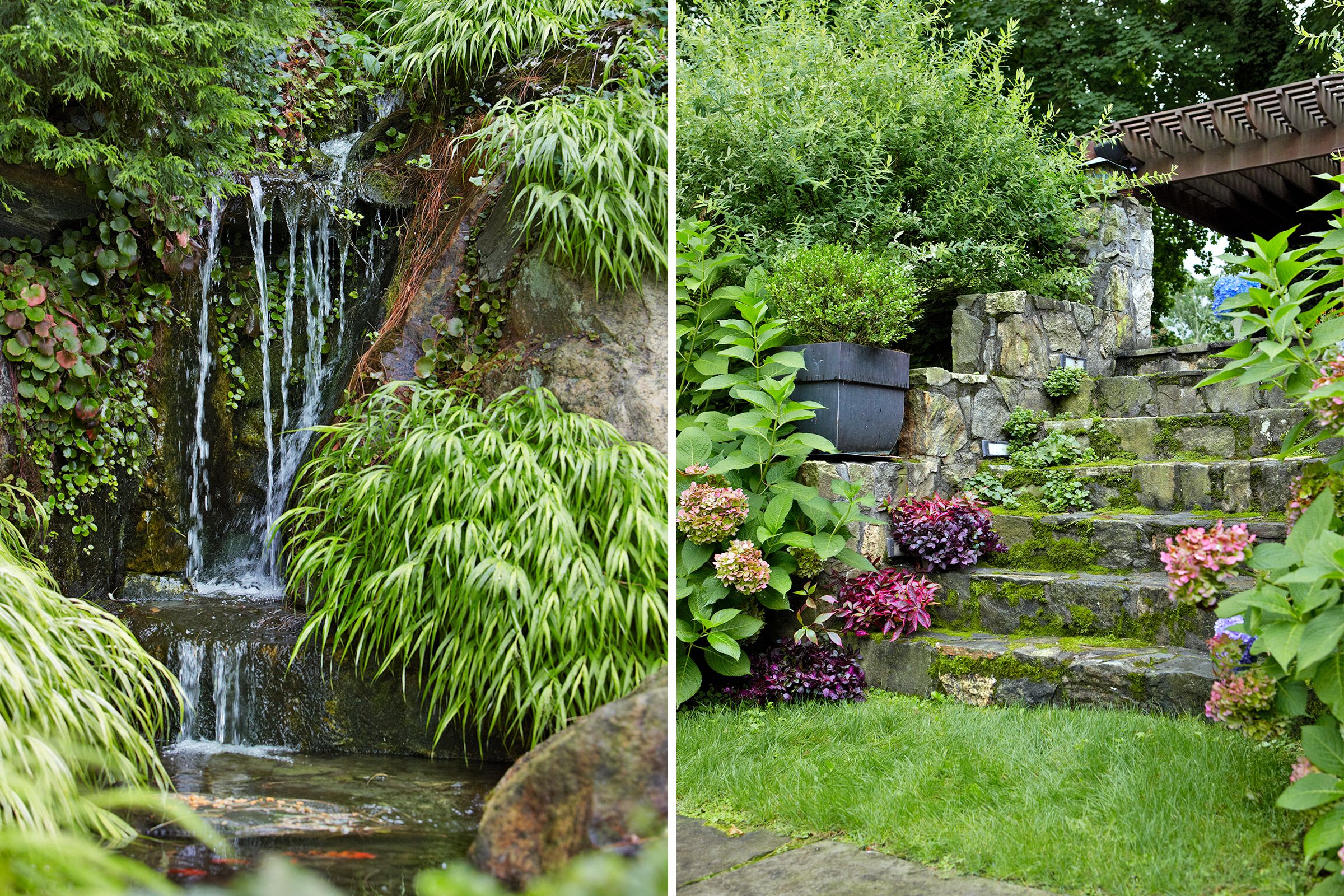
Waterfall
Secure “dust bowl” soil with water-thrifty plants. Bare hillsides wash out in the rain and blow away in the summer. These challenges lingered in an unruly corner off the garage, bordered on two sides by the street—a kind of steeply pitched hellstrip where turf struggled and mowing wasn’t really an option anyway.
After preparing the plot with topsoil, Welsch mapped out a garden of drought-tolerant blooming perennials and ornamental grasses that attract birds and butterflies and don’t require much tending beyond a good cutting back before winter. Helianthus, echinacea, Shasta daisy, tickseed, rudbeckia, and baptisia are some of the plants in this prairie garden, which runs 120 feet long, narrowing from 25 feet wide at the top to just 3 feet at its tip.
Trees like a Japanese cedar form a backdrop against the house, while deep-rooted ornamental grasses work to hold the soil in place. Regular mulching discourages weeds. A yew hedge screen out the street, and a curved path and stone bench encourage visitors to pause and enjoy the show, as some 350 species send out color and fragrance—just what the owners were after.
Fieldstone Stairs
A staircase of Pennsylvania fieldstone ascends from the small lawn centered behind the house to the expansive entertaining terrace. This outdoor room adjoins the patio attached to the house and includes a summer kitchen with a mahogany pergola. A potted boxwood orb centered on the stone wall is joined by ‘Endless Summer’ hydrangea, adding deep color on each side. A variegated willow at the top left of the steps further softens the stonework.
Patio
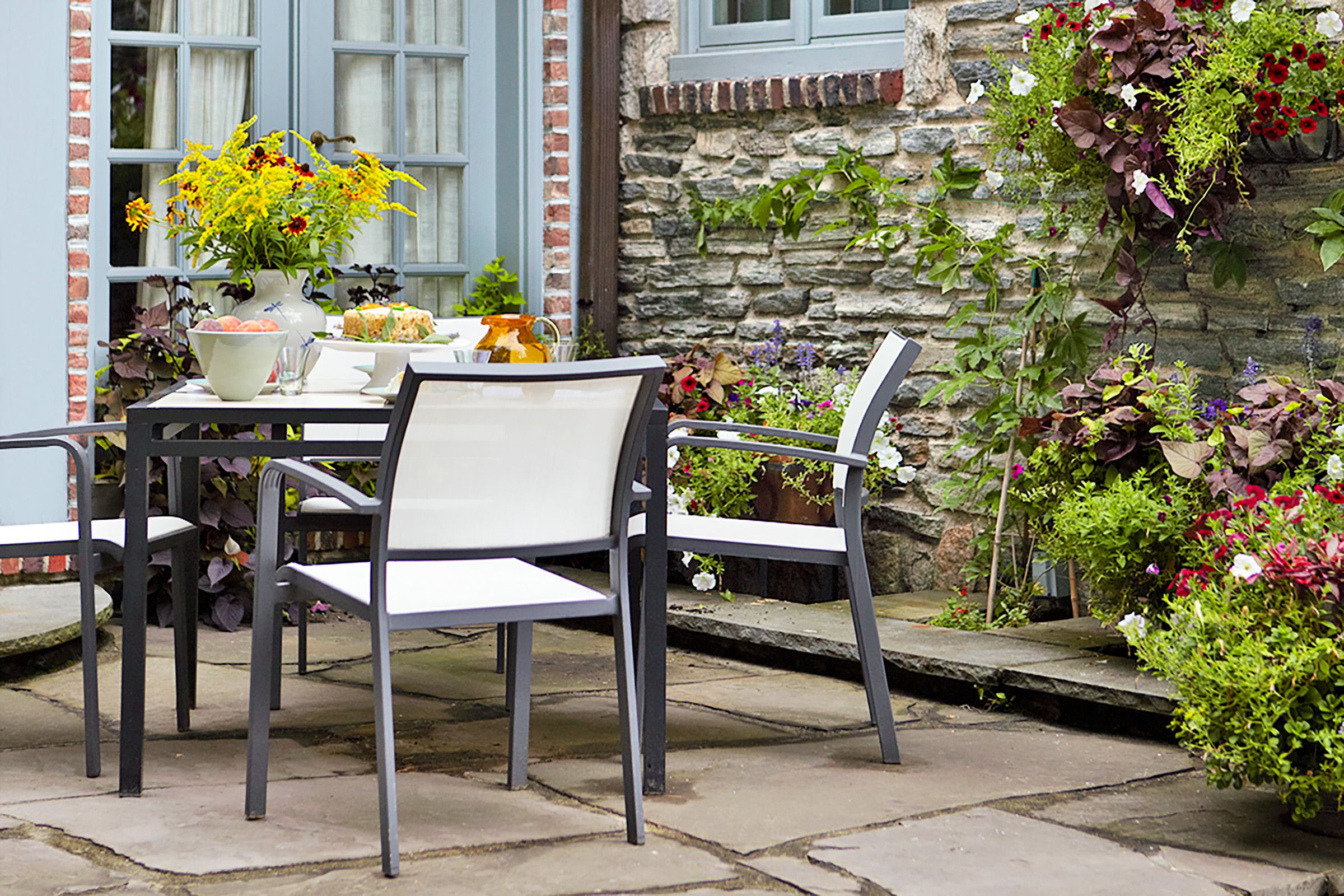
This patio off the family room and the entertaining terrace below it were the only level surfaces in the backyard before designer Robert Welsch began work. The mix of colorful annuals in containers includes plants chosen for their aromatic blossoms, like the passionflower vine that trails along the wall to help break up the hard expanse of the house’s stone-and-brick exterior.
Stone Buddha
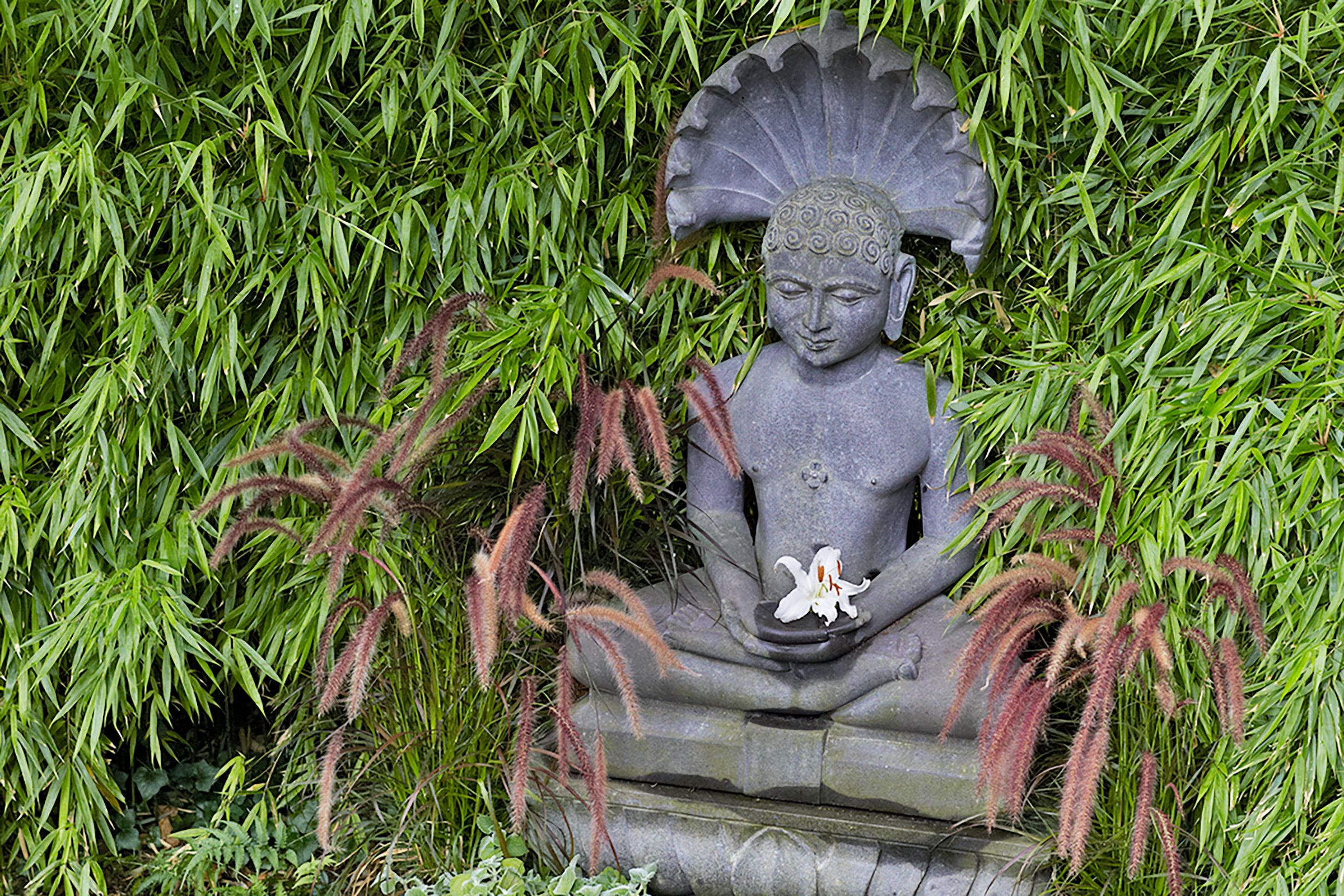
A stone Buddha sculpture in the shade garden nestles into a backdrop of bamboo accented with the fuzzy flower spikes of black fountain grass.
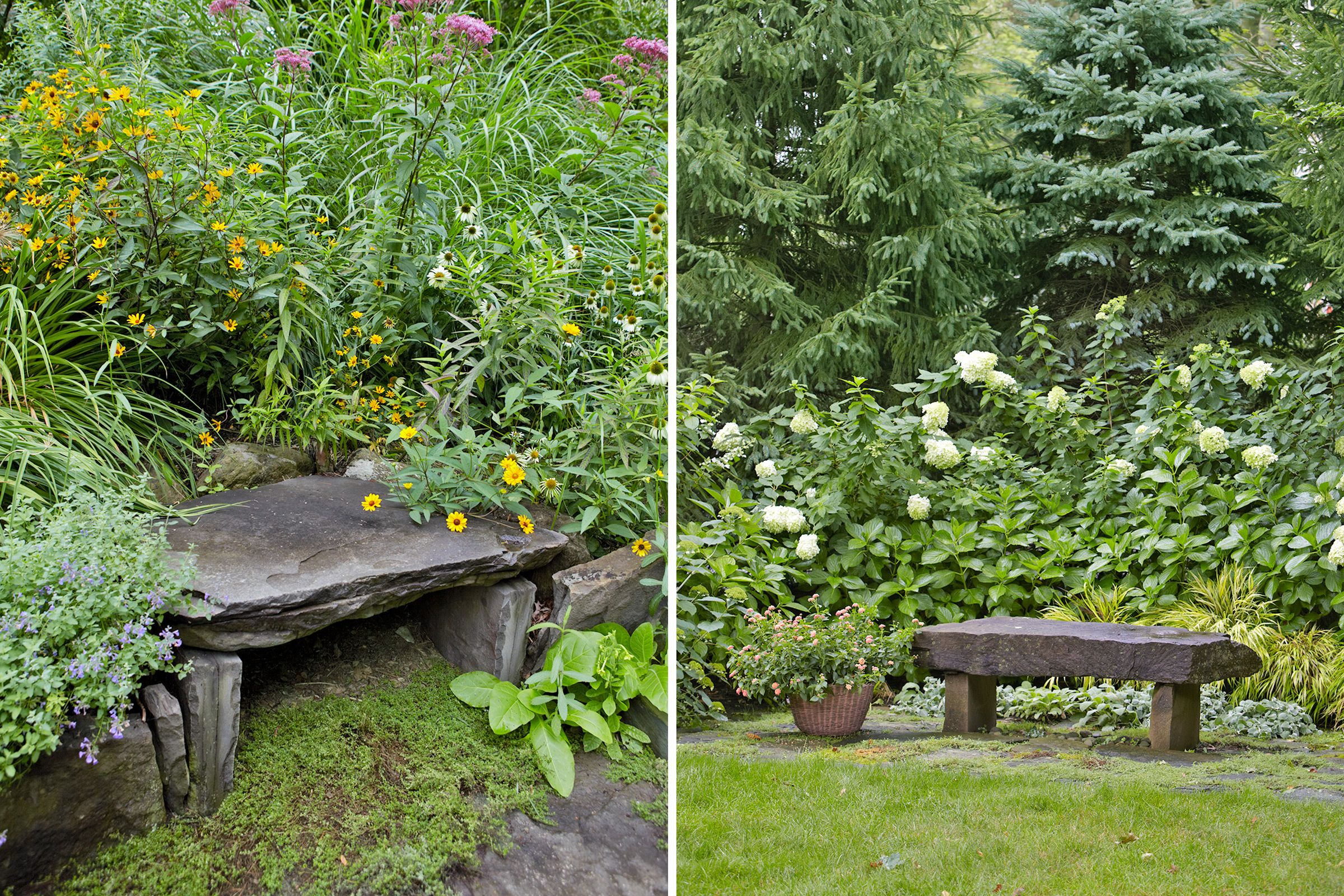
Resting Spot
Yellow-blooming helianthus and tall, pinkish-purple Joe Pye weed brighten this resting spot in the prairie garden. Catmint at the foot of the bench releases fragrance when visitors brush past.
Stone Bench
At the far end of the lawn, a stone bench provides a view up to the terraced turf steps and the house. ‘Tardiva’ hydrangea and stately evergreens, including a Colorado blue spruce, shield the setting from the street.
Natural Wall
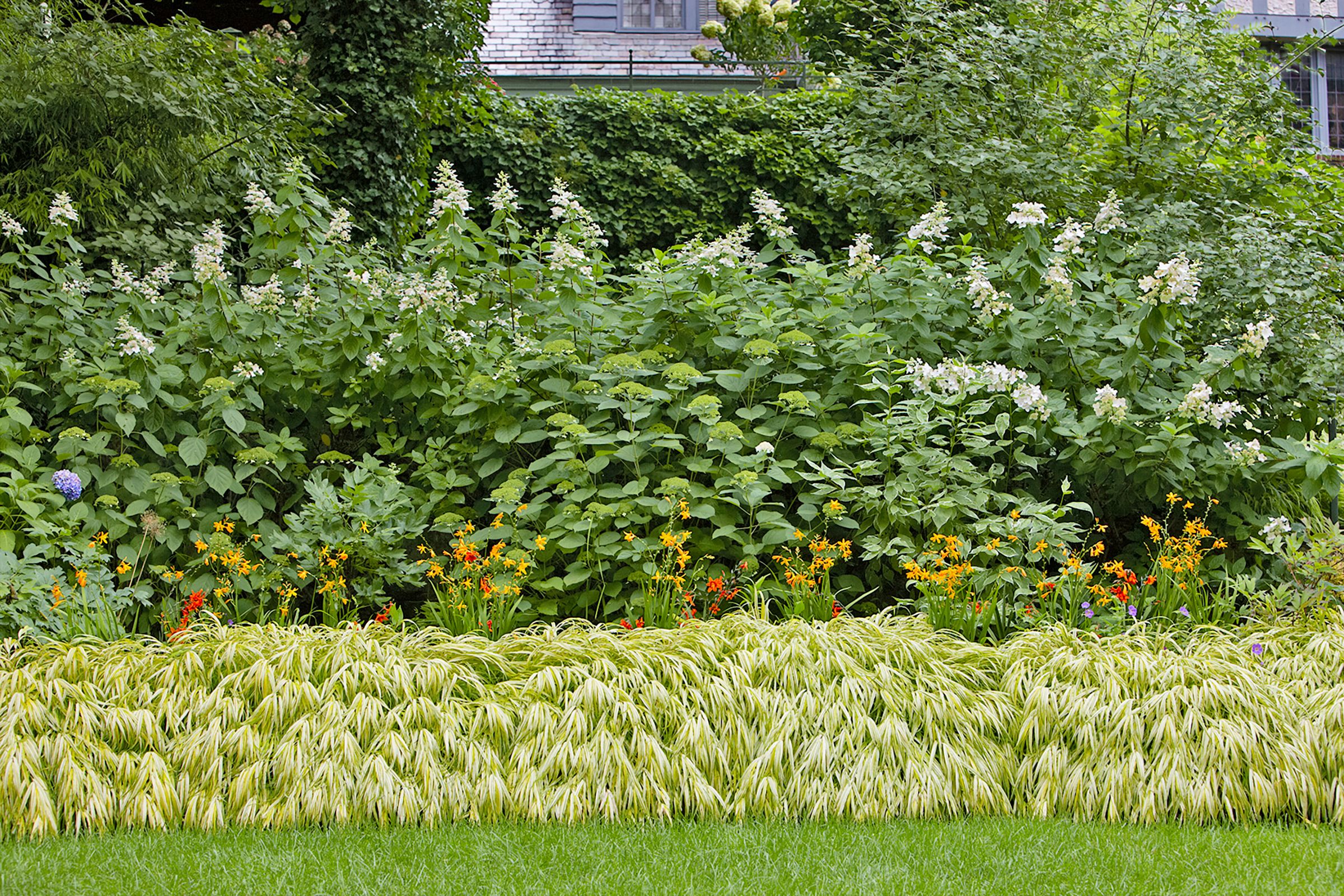
‘Tardiva’ hydrangea, red and yellow crocosmia, and a flowing hakonechloa layer height and color while forming a kind of wall between garden areas.
